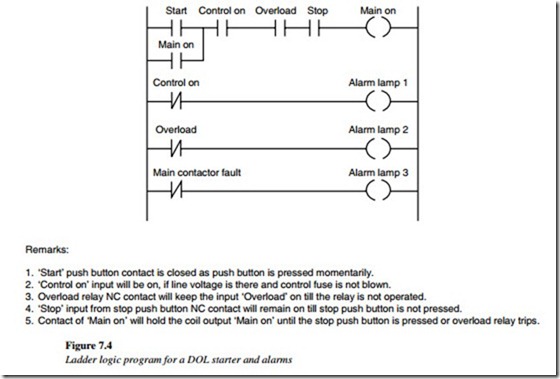Ladder logic circuits
The designing, programing, testing, commissioning, troubleshooting, and maintenance of control logic are much easier using the ladder logic programs in a PLC than in hard-wired circuit.
We have discussed the ladder logic instructions before and looked at the simple ladder logic programs in Chapter 2. Let us consider a ladder logic program for a typical control
circuit of the DOL starter for a three-phase motor as shown in Figure 7.1(a).
For a three-phase motor with a DOL starter, the following input and output signals are configured in the PLC.
Digital inputs
1. Control voltage ON and control fuse ‘F3’ OK (normally open)
2. Motor overload ‘F2’ (normally closed)
3. Motor stop ‘S0’ (normally closed)
4. Motor start ‘S1’ (normally open)
5. Main contact on feedback (normally open).
Digital output
Main contactor on
The ladder logic program Instructions for the DOL starter control circuit with a maintained contact control is shown in the Figure 7.4.
As various inputs for the control circuit in the PLC has been gathered, it will be for generating alarms. These alarms can be indicated with the help of ‘Indication Lamps’ that can be mounted on the motor starter panel in addition to the start and stop pushbuttons. These alarms can help in faultfinding. The following alarms can be configured using the inputs already available in the PLC. The PLC outputs can be generated to drive these alarm indication lamps.
In case of the DOL starter for a three-phase motor, the following alarms can be configured to indicate faults:
• Alarm indication lamp-1: Control voltage OFF
• Alarm indication lamp-2: Motor tripped on overload
• Alarm indication lamp-3: Main contactor feedback fault.
Related posts:
Incoming search terms:
- ladder logic diagram for dol starter
- dol starter ladder diagram
- dol starter PLC ladder diagram
- plc lader diagram in dol starter
- plc diagram of dol starter
- dol starter plc
- Dol starter in pl
- ladder diagram for direct online
- dol starter ladder
- motor control starter ladder logic with lamp
- dol starter ladder logic diagram
- dol feeder circuit diagram plc feedback
- what is lader diagram of direct on line starting method
- ladder diagram of dol starter
- Direct Online Lader Diagram
- ladder diagram sistem DOL
- findthe ladder logic diagram of direct starting mechanism of motor ?
- DOL stater lader diagram
- dol starter plc logic
- ladder logic diagram for direct on line motor starter
- installation diagram of plc controlling direct online circuit
- ladder diagram for dol starter with proper on feedback for light indication
- how to troubleshoot plc ladder logic
- ladder diagram of dol operation
- Iadder with dol starter
- jow plc feedback wiring in dol strter control circuit
- ladder diagram for a direct online control circuit
- ladder diagram of a DOL CIRCUIT With thermo overload
- ladder diagram for dol starter
- ladder diagram for simple Direct ON LINE STARTER
- dol starter plc ladder
- dol starter plc diagram
- dol ladder circuit diagram
- dol control ladder diagram
- Dol control diggram ladder
- direct online starter control diagram with plc
- direct online lader daigram
- direct on line ladder logic
- direct on line ladder diagram
- diploma of electronic to troubleshoot ing in plc ladder diagram
- what is the ladder logig diagram of dol starter
- Dol starter circuit and ladder diagram
- dol starter plc connection diagram
- dol starter lader logic
- dol starter lader
- dol starter ladder logic exercises
- dol starter in plc
- dol starter in ladder logic
- dol starter image in plc ladder
- dol starter diagram With Plc Control Ckt
